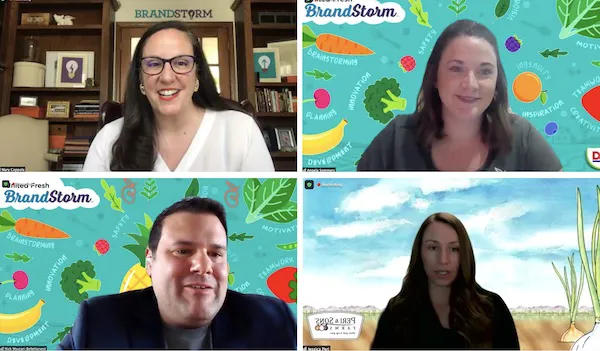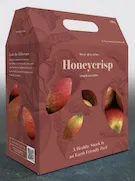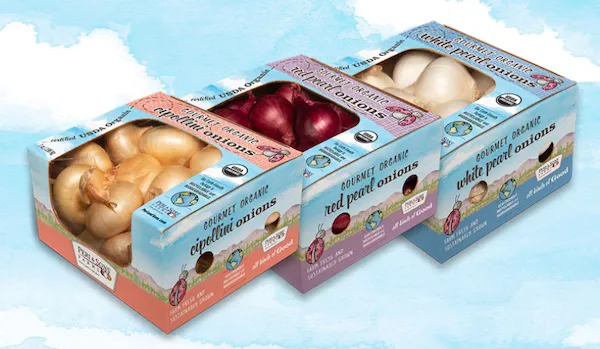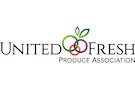Yesterday marked the final day of the United Fresh Produce Association BrandStorm event. One of the final webinar discussions of the day looked at sustainable packaging. Led by Mary Coppola of United Fresh, Angela Sommers and Nick Mascari of Belle Harvest and Jessica Peri of Peri & Sons Farms talked about how they launched their sustainable packaging projects, how retailers have received these projects and what they think the future of sustainable packaging will look like.

Sustainable packaging options: From compostable to recyclable One of the first steps to take as a company when you start the journey toward sustainable packaging is to find out what exactly you want to accomplish, says Sommers. The Michigan-based apple supplier Belle Harvest released their new paperboard-based packaging this past fall for their 3-lb apple category. “The first and foremost step was getting organized and understanding what we want. For us, that was providing a recyclable option for our customers, which is why we chose to work with a fiber-based product. It was a long process: We spent about a year developing it and we are still learning. What we have now isn’t the final product, we are taking in all feedback and will adjust this first edition from there.”
One of the first steps to take as a company when you start the journey toward sustainable packaging is to find out what exactly you want to accomplish, says Sommers. The Michigan-based apple supplier Belle Harvest released their new paperboard-based packaging this past fall for their 3-lb apple category. “The first and foremost step was getting organized and understanding what we want. For us, that was providing a recyclable option for our customers, which is why we chose to work with a fiber-based product. It was a long process: We spent about a year developing it and we are still learning. What we have now isn’t the final product, we are taking in all feedback and will adjust this first edition from there.”
At Peri & Sons Farms, the team went for a compostable, biodegradable option. “Sustainable farming is at the core of our company, so we wanted to ensure that our products were being brought to market sustainably too, and that meant working toward sustainable packaging,” Peri shares. “We found that the right option for us was a biodegradable and recyclable packaging option, which we started using with our organic onions. It is a paper clamshell with a cellulose, plant-based film that serves as a window, and was done through Warren Packaging. Packaging goes hand-in-hand with marketing and we always want to bring new and innovative ideas to the market and really brand our onions rather than sell them as a commodity. That is why this packaging option works best for us,” she adds.

Retail reception
While both Belle Harvest and Peri & Sons Farms developed and released sustainable packaging options around the same time, the reception they received from retailers was vastly different. “We really saw great reception from retailers,” Peri says. “We released the packaging for our organic onions, and that pairing worked out really well and we sold out quickly.”
For Belle Harvest, the road was a bit more difficult. Mascari shares: “Early on, it really wasn’t received well because it was so different, and retail buyers were quick to shy away from it. There seems to be a bit of a disconnect there because the push for sustainable packaging is coming from both consumers and corporate retailers, but when we put the product in front of the retail buyers it suddenly became a hard sell.” Fortunately, Mascari and Belle Harvest developed the right strategy to launch the new packaging into the market: “We put a program together and guaranteed the sale for several retailers to get it in their stores. This paid off and our 3-lb apple packs in the new sustainable packaging out-sold the conventionally packed apples 3 to 1.”
Consumer messaging
Throughout the BrandStorm sessions, the importance of clear communication to consumers has been a red thread. With developing sustainable packaging, it is no different. “It is very important to be clear in the messaging you put onto the packaging itself. Help consumers understand what you are doing, why the packaging is sustainable, and how it helps the planet. Have a concise and consolidated message so the consumers understand what they are buying,” Peri explains.
Sommers agrees, saying: “The consumers have spoken out and let us know that they want to see sustainable packaging for our products. So, we have to make sure they know that we listened. We have to tell them our story.”
For companies who want to be more sustainable in their packaging but aren’t sure where to start, Peri recommends starting small: “Every little change matters, each small step can make a big difference in the long term.”
 For more information:
For more information:
Mary Coppola
United Fresh Produce Association
Tel: +1 (202) 303-3425
Email: mcoppola@unitedfresh.org
www.unitedfresh.org
